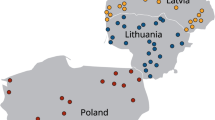Abstract
We compared the gastrointestinal parasites of the baboon,Papio cynocephalus ursinus, living in montane (altitude, >1800 m) and coastal lowland (altitude, 100–200 m) habitats in Natal, South Africa, using fecal analysis. While the montane animals harbored a smaller number of species, helminth egg-output rates were higher in them than in the lowland animals. The decrease in parasite diversity with increasing altitude was expected, but the difference in helminth egg output was not. It may be due to a combination of food shortage, which characterizes the montane environment, especially at the end of winter, and the high proportion of soil-contaminated items in the diets of the montane animals.
Similar content being viewed by others
References
Allen, A. V. H., and Ridley, D. S. (1970). Further observations on the formol-ether concentration technique for fecal parasites.J. Clin. Pathol. 23: 545–547.
Appleton, C. C., Henzi, S. P., Whiten, A., and Byrne, R. (1986). The gastrointestinal parasites ofPapio ursinus from the Drakensberg mountains, Republic of South Africa.Int. J. Primatol. 7: 449–456.
Appleton, C. C., Henzi, S. P., and Whitehead, S. I. (1991). Gastrointestinal helminth parasites of the Chacma baboon,Papio cynocephalus ursinus, from the coastal lowlands of Zululand, South Africa.Afr. J. Ecol. 29: 149–156.
Bryan, R. P., and Kerr, J. D. (1989). Factors affecting the survival and migration of the free-living stages of gastrointestinal parasites of cattle in central Queensland.Vet. Parasitol. 30: 315–326.
Byrne, R. W., White, A., and Henzi, S. P. (1990). Measuring the food constraints on mountain baboons. In Thiago de Mello, M., Whiten, A., and Byrne, R. W. (eds.),Baboons: Behavior and Ecology, Use and Care, Brasilia, pp. 105–122.
Bundy, D. A. P., and Golden, M. H. N. (1987). The impact of host nutrition on gastro-intestinal helminth populations.Parasitology 95: 623–635.
Cheesbrough, M. (1981).Medical Laboratory Manual for Tropical Countries, Vol. 1, Stephen Austin & Sons, Hertford.
Cowling, R. M., Gibbs-Russell, G. E., Hoffman, M. T., and Hilton-Taylor, C. (1989). Patterns of plant species density in southern Africa. In Huntley, B. J. (ed.),Biotic Diversity in Southern Africa, Oxford University Press, Cape Town, pp. 19–50.
Crompton, D. W. T. (1986). Nutritional aspects of infection.Trans. Roy. Soc. Med. Hyg. 80: 697–705.
Freeland, W. J. (1976). Pathogens and the evolution of primate sociality.Biotropica 8: 12–24.
Hall, A. (1985). Nutritional aspects of parasitic infections.Prog. Food Nutr. Sci. 9: 227–256.
Hausfater, G., and Meade, B. J. (1982). Alternation, of sleeping groves by yellow baboons (Papio cynocephalus) as a strategy for parasite avoidance.Primates 23: 287–297.
Hausfater, G., and Watson, D. F. (1976). Social and reproductive correlates of parasite ova emissions by baboons.Nature (Lond.) 262: 688–689.
Henzi, S. P., Dyson, M. L., and Deenik, A. (1990). On the relationship between altitude and group size in mountain baboons (Papio c. ursinus).Int. J. Primatol. 11: 319–325.
Henzi, S. P., Byrne, R. W., and Whiten, A. (1992). Patterns of movement by baboons in the Drakensberg mountains. I. Primary responses to the environment.Int. J. Primatol. 13: 601–629.
Michael, E., and Bundy, D. A. P. (1990). Effect of protein nutrition-immunity interaction on the transmission dynamics of murine trichuriasis.Bull. Soc. Fr. Parasitol. 8 (Suppl. 2): 685.
Poinar, G. O., and Hess, R. (1974). An ultrastructural study of the response ofBlatella germanica (Orthoptera: Blattidae) to the nematodeAbbreviata caucasica (Spirurida: Physalopteridae) in an intermediate host.J. Parasitol. 58: 23–28.
Poinar, G. O., and Quentin, J. C. (1972). The development ofAbbreviata caucasica (Von Linstow) (Spirurida: Physalopteridae) in an intermediate host.Int. J. Parasitol. 58: 23–28.
Scotcher, J. S. B. (1982).Interrelations of Vegetation and Eland (Taurotragus oryxPallas) in Giant's Castle Game Reserve, Natal, Unpublished Ph.D. thesis, University of the Witwatersrand.
Sharman, M., and Dunbar, R. I. M. (1982). Observer bias in selection of study groups in baboon field studies.Primates 23: 567–573.
Smith, G. (1990). The ecology of the free-living stages: A reappraisal. In Schad, G. A., and Warren, K. S. (eds.),Hookworm Disease: Current Status and New Directions, Taylor & Francis, London, pp. 89–104.
Whiten, A., Byrne, R. W., and Henzi, S. P. (1987). The behavioral ecology of mountain baboons.Int. J. Primatol. 8: 367–388.
Author information
Authors and Affiliations
Rights and permissions
About this article
Cite this article
Appleton, C.C., Henzi, S.P. Environmental correlates of gastrointestinal parasitism in montane and lowland baboons in Natal, South Africa. International Journal of Primatology 14, 623–635 (1993). https://doi.org/10.1007/BF02215451
Received:
Revised:
Accepted:
Issue Date:
DOI: https://doi.org/10.1007/BF02215451




